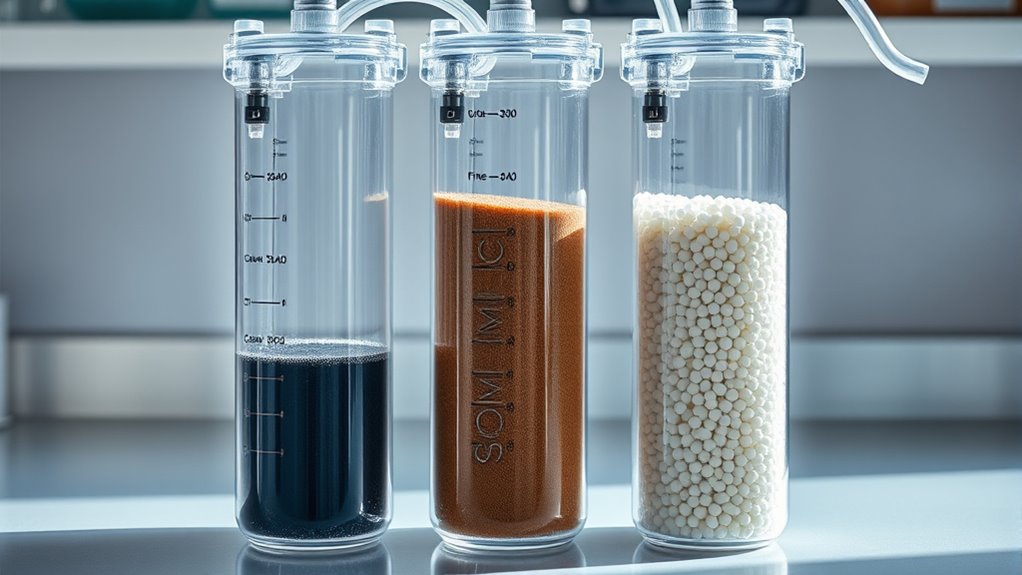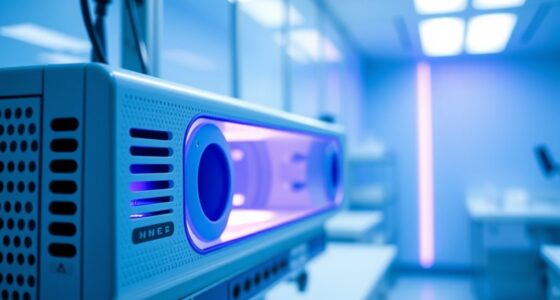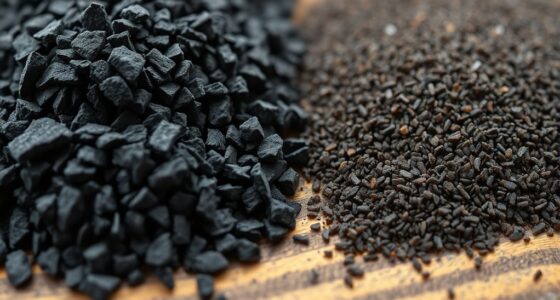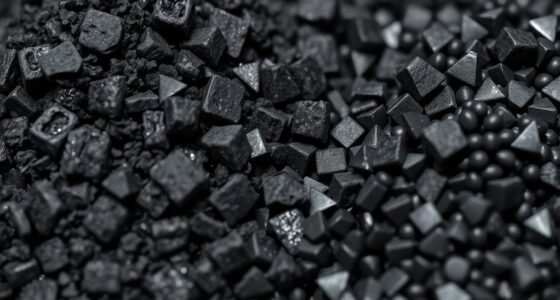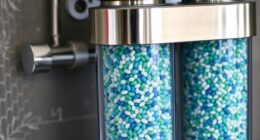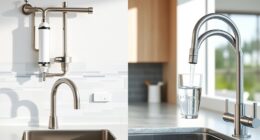To plan a multi-stage filtration system, start with a sediment filter to remove dirt, rust, and particles, ensuring better performance of subsequent stages. Next, add activated carbon filters to eliminate chemicals, chlorine, and odors. Depending on water quality, consider additional stages like reverse osmosis or UV sterilizers for dissolved solids or bacteria. Carefully selecting and sequencing these stages helps you achieve effective, long-lasting filtration—keep exploring to learn how to optimize your system further.
Key Takeaways
- Identify specific contaminants in your water to determine necessary filtration stages.
- Start with sediment filters to remove dirt, rust, and particles, protecting subsequent media.
- Use activated carbon filters to eliminate chemicals, chlorine, VOCs, and odors.
- Incorporate specialized stages like reverse osmosis or UV sterilization for dissolved solids and bacteria.
- Design the system sequentially, ensuring each stage targets particular contaminants for optimal water quality.
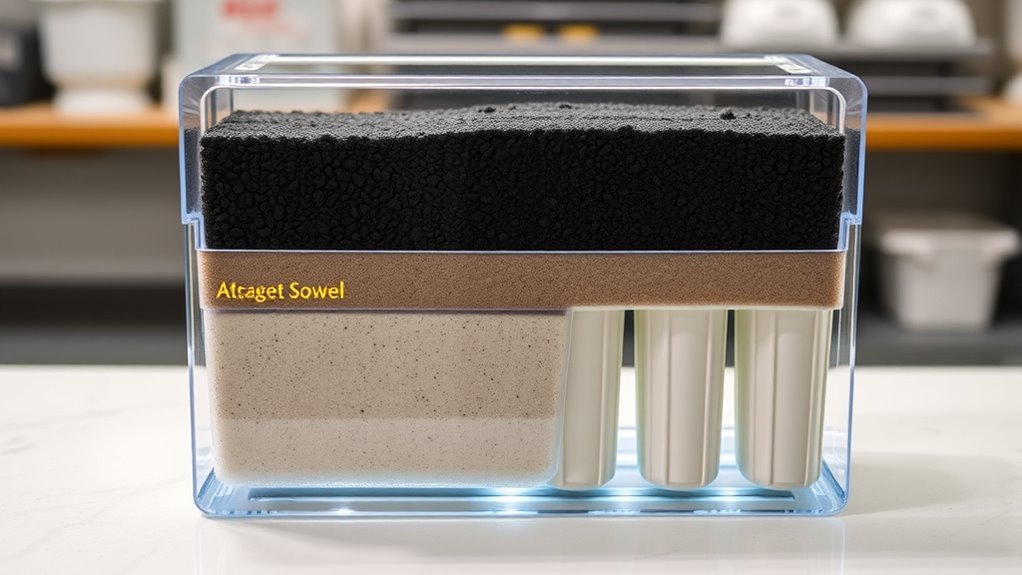
Designing a multi-stage filtration system begins with understanding your water quality needs and the contaminants you want to remove. Once you’ve identified those, you can start planning the specific stages that will effectively address each issue. The first step involves selecting appropriate filter media for each stage. Different filter media target different contaminants; for instance, activated carbon excels at removing chlorine, volatile organic compounds, and bad odors, while sediment filters trap dirt, sand, and rust particles. Knowing what you need to eliminate helps you choose the right media for each layer of your system, guaranteeing maximum efficiency.
Start your multi-stage filtration system by selecting the right media for each contaminant targeted.
Next, you should consider how to integrate these media into a cohesive system. The installation process is critical because it determines how smoothly your filtration system functions over time. Typically, you’ll set up the stages in sequence, beginning with a sediment filter to catch larger particles. This prevents clogging of subsequent filters and prolongs their lifespan. After that, a carbon filter can follow, reducing chemicals and improving taste and smell. Depending on your water quality, you might include additional stages, such as a reverse osmosis membrane or UV sterilizer, to target dissolved solids or bacteria.
When planning the installation process, pay close attention to the flow rate and pressure requirements of each stage. You want to guarantee that water flows steadily through each filter without causing backpressure or leaks. Properly fitting all filter housings and securely sealing connections minimizes the chance of contamination or leaks down the line. If you’re installing the system yourself, read the manufacturer’s instructions thoroughly and prepare your workspace beforehand. It’s wise to have all necessary tools ready—wrenches, tubing cutters, and Teflon tape—to facilitate a smooth setup.
Additionally, consider the placement of your filters. Installing the system in an accessible, dry location makes maintenance easier. Regularly replacing or cleaning filter media is essential for maintaining water quality, so plan for easy access to each stage. When replacing media, follow specific guidelines for each filter type to avoid damage and ensure proper operation. This might involve flushing filters after installation or replacement to eliminate air pockets and guarantee optimal flow.
Frequently Asked Questions
How Do I Determine the Appropriate Number of Filtration Stages?
You determine the right number of filtration stages by evaluating your water’s filter capacity needs and the system’s complexity. Start by testing your water quality to identify contaminants, then match the number of stages to effectively remove those impurities. If your water has multiple pollutants, add more stages for thorough treatment. Keep in mind, more stages increase system complexity, so balance filtration efficiency with ease of maintenance.
What Are the Best Materials for Each Filtration Stage?
For each filtration stage, select filter material options that optimize filtration performance. For example, a sediment filter might use polypropylene for its durability, while activated carbon effectively removes chemicals and odors. Using high-quality materials guarantees your system effectively targets contaminants. You’ll want to match materials to specific impurities, boosting overall filtration performance and extending filter lifespan. This tailored approach guarantees cleaner, safer water at each stage.
How Often Should I Replace or Maintain Each Filter?
You should replace or maintain each filter based on its filter lifespan and your maintenance schedule. Typically, pre-filters need changing every 1-3 months, carbon filters every 6-12 months, and membrane filters every 12-24 months. Regular inspections help you stay on top of these intervals, ensuring peak performance. Keep a maintenance schedule to track when each filter was last replaced, and follow manufacturer recommendations for best results.
Can a Multi-Stage System Remove All Types of Contaminants?
A multi-stage filtration system can remove many contaminants, including bacteria, chemicals, and sediments, but it may not eliminate all types, especially dissolved minerals or gases. Water mineralization can affect taste and health, so consider filters designed for that purpose. Remember, each filter has a specific lifespan; regular maintenance guarantees maximum contaminant removal. While multi-stage systems are highly effective, occasional testing helps confirm your water’s purity.
What Is the Average Cost of Installing a Multi-Stage Filtration System?
The cost of installing a multi-stage filtration system can sometimes feel like buying a small house, averaging $600 to $2,500. Your cost estimation depends on factors like filter quality and system complexity. During the installation process, you’ll work with professionals who assess your needs, select components, and guarantee everything fits perfectly. Be prepared for potential additional costs if upgrades or extra features are desired to keep your water pure and safe.
Conclusion
Now that you know the essential stages for your filtration system, you’re ready to create a clean, safe water supply. Did you know that multi-stage filters can remove up to 99% of contaminants? That’s like giving your water a powerful shield against impurities. By carefully planning each stage, you guarantee the best quality and longevity for your system. With the right setup, you’ll enjoy fresh, pure water every day—making all your efforts totally worth it.
